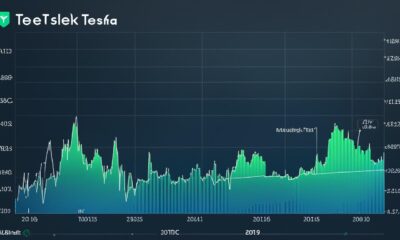Business
The Strategic Bet: How Much Cash Google is Investing in AI Technology

In the fast-paced world of technology, innovation is the key to staying ahead. For Google, the flagship subsidiary of Alphabet Inc. (NASDAQ: GOOG), the last decade has been a testament to the growing importance of artificial intelligence (AI) in its overarching strategy. Google, known for its search engine and an array of tech services, is now heavily investing in AI technologies. This article delves into the extent of Google’s investment in AI, its strategic importance, and how these investments might impact Google stock and the broader technology landscape.
The Evolution of Google’s AI Strategy
Google’s journey with AI began long before it became a buzzword in the tech industry. From improving search algorithms to enhancing the capabilities of Google Assistant, AI has been at the heart of Google’s technological evolution. Over the years, Google has transitioned from being just a search engine to becoming a pioneer in AI, with applications spanning across various domains including cloud computing, autonomous vehicles, and healthcare.
One of the most significant indicators of Google’s commitment to AI is its acquisition strategy. Alphabet Inc. has invested billions of dollars into acquiring AI startups that specialize in machine learning, natural language processing, and computer vision. For instance, the acquisition of DeepMind in 2014, a British AI company renowned for its groundbreaking work in deep learning, marked a turning point in Google’s AI ambitions. This $500 million purchase was a clear signal that Google was serious about leveraging AI to not only improve its existing products but to also create new ones.
Financial Commitment: The Scale of Google’s AI Investments
While exact figures on Google’s AI investments are not always publicly disclosed, it is estimated that Alphabet Inc. has invested tens of billions of dollars into AI over the past decade. This includes both direct investments in research and development as well as strategic acquisitions.
According to reports, Alphabet Inc. spent over $31 billion on research and development in 2023 alone, a significant portion of which was directed towards AI initiatives. This R&D budget is one of the largest in the tech industry and highlights the critical role AI plays in Google’s strategy. For context, this is nearly 30% of Google’s revenue, a massive commitment compared to other tech giants. The scale of these investments suggests that Google is not just exploring AI; it is betting its future on it.
Google’s investment in AI is not just limited to internal development. The company has been actively investing in AI startups through its venture capital arms, Google Ventures (GV) and Gradient Ventures. These investments are designed to foster innovation outside the company’s walls and to ensure that Google remains at the forefront of AI developments globally.
In terms of infrastructure, Google has also invested heavily in AI-related technologies like Tensor Processing Units (TPUs), custom-built processors that accelerate machine learning tasks. These TPUs are not only used internally but are also offered as a service on Google Cloud, enabling other companies to leverage cutting-edge AI without needing to build the infrastructure themselves.
Strategic Acquisitions: Building an AI Powerhouse
Google’s acquisition strategy is a significant part of its AI investments. The company has acquired over 50 AI startups since 2007, making it one of the most aggressive acquirers in the space. These acquisitions have not only brought in valuable intellectual property but also some of the brightest minds in AI.
The most notable acquisition, as mentioned earlier, was DeepMind. Since the acquisition, DeepMind has become a cornerstone of Google’s AI efforts, with its research contributing to advancements in healthcare, energy efficiency, and gaming, among other fields. DeepMind’s AlphaGo, an AI program that defeated a world champion Go player, is a prime example of the cutting-edge research being done at Google.
Another key acquisition was Kaggle, a platform for data scientists and AI practitioners to collaborate and compete on machine learning challenges. This acquisition helped Google bolster its AI community and talent pool, further reinforcing its position as a leader in AI.
Google has also invested in AI through its cloud computing arm, Google Cloud. In 2019, Google acquired Looker, a data analytics company, for $2.6 billion. While not purely an AI company, Looker’s capabilities in data analysis are crucial for developing AI models, particularly in the enterprise space where data-driven decision-making is key.
AI’s Role in Google’s Product Ecosystem
Google’s AI investments have led to significant enhancements across its product ecosystem. From search and advertising to hardware and cloud services, AI is integrated into nearly every aspect of Google’s operations.
- Search and Advertising: AI has revolutionized how Google Search functions. With the introduction of RankBrain and BERT, Google has significantly improved its ability to understand and process natural language queries. This has led to more accurate search results and a better user experience. Additionally, AI is used extensively in Google’s advertising platforms, helping to optimize ad targeting and maximize return on investment for advertisers. Given that advertising accounts for a large portion of Google’s revenue, the use of AI in this area is crucial.
- Google Assistant and AI-Powered Devices: Google Assistant is one of the most visible manifestations of Google’s AI prowess. Leveraging natural language processing and machine learning, Google Assistant offers personalized, context-aware interactions that are becoming increasingly sophisticated. Google’s AI-powered hardware products, such as the Google Home series and Pixel phones, also rely heavily on AI to deliver advanced features like real-time language translation and AI-driven photography.
- Google Cloud: AI is a central part of Google Cloud’s strategy. With a suite of AI and machine learning tools available to enterprises, Google Cloud enables businesses to build and deploy AI models at scale. Services like AutoML and AI Platform are designed to democratize AI, making it accessible even to those without deep technical expertise. This not only strengthens Google Cloud’s competitive position but also drives revenue growth in a highly competitive market.
- Healthcare and Life Sciences: Google’s investments in AI have also extended into healthcare, a sector ripe for disruption through technology. Google Health, another division within Alphabet, is leveraging AI to tackle some of the most challenging problems in healthcare, such as early disease detection and personalized medicine. Projects like using AI to analyze medical images for cancer detection or predicting patient outcomes based on electronic health records are prime examples of the potential impact of AI in this field.
- Autonomous Vehicles: Waymo, another Alphabet subsidiary, is a leader in autonomous vehicle technology. AI is at the core of Waymo’s self-driving cars, which are equipped with advanced sensors and software capable of navigating complex driving environments. The success of Waymo’s technology could have significant implications for the future of transportation, making it one of the most exciting areas of Google’s AI investments.
Impact on Google Stock (NASDAQ: GOOG)
Investors have taken note of Google’s strategic shift towards AI, and it has been a critical factor in the performance of Google stock (NASDAQ: GOOG). As AI continues to evolve and become more integrated into the global economy, Google’s early and substantial investments are likely to pay off in the long run.
The confidence in Google’s AI strategy is reflected in its stock performance. Over the past five years, NASDAQ: GOOG has seen significant growth, driven by the company’s continued dominance in search and advertising, as well as its expanding cloud business. AI is seen as a key growth driver, with analysts frequently citing it as a reason for their bullish outlook on Google stock.
However, it’s important to recognize that AI investments also come with risks. The technology is still evolving, and there are significant challenges, such as ethical concerns, regulatory hurdles, and the high costs associated with AI research and development. These factors could impact the return on investment from Google’s AI initiatives, potentially leading to volatility in its stock price.
The Future of Google and AI
As we look ahead, it’s clear that Google’s future is deeply intertwined with AI. The company’s massive investments in AI technology position it at the forefront of the next wave of technological innovation. From transforming industries to creating new ones, the potential applications of AI are vast, and Google is well-placed to capitalize on these opportunities.
Moreover, as AI becomes more ubiquitous, Google’s role as a leader in this space will likely have broader implications for its business model and the global economy. The company’s ability to monetize its AI investments while navigating the challenges of this rapidly changing landscape will be crucial in determining its future success.
In conclusion, Google’s extensive cash investment in AI technology is not just a strategic priority; it is a fundamental part of its identity moving forward. For investors in Alphabet Inc., understanding the scope and scale of these investments is essential for evaluating the long-term potential of Google stock. While challenges remain, Google’s relentless pursuit of AI innovation is likely to yield substantial returns, both for the company and for its shareholders, making NASDAQ: GOOG a stock to watch closely in the coming years.
Business
Top Picks: Hot Stocks To Buy Now for Growth

If you’re looking to grow your investments, you might want to focus on stocks that could see big price jumps. These are companies that grow their earnings and revenue faster than others. Big names like Apple, Microsoft, Amazon, Tesla, and Alphabet have led the market’s growth over the last ten years.
But growth stocks aren’t just in tech. Health care and finance sectors also have their share of growth leaders. For example, Intuitive Surgical, Inc. (ISRG) has a strong 52.2 quarterly rating, and Citigroup, Inc. (C) scored a 50.8. These companies reinvest their profits to grow and innovate.
When picking growth stocks, look for those likely to quickly increase in value. Recent data from May 31, 2024, highlights companies like Spotify Technology S.A. (SPOT) and The Progressive Corporation (PGR) as promising investments. PayPal and Shopify are also doing well, along with Airbnb and MercadoLibre, which saw a 83% increase in sales last year. Walt Disney Company is another example of a company showing strong growth potential.
As you explore growth investing, consider adding these top stocks to your portfolio. Focus on sectors that are at the forefront of technology for a strong investment strategy. This approach can help you achieve better stock market performance and diversify your portfolio.
Understanding Growth Stocks: A Gateway to High Potential Returns
In today’s market, growth stocks are key to growth investing. They have strong earnings growth and add a lot to the S&P 500 index. But what makes them stand out among many investment options?
Defining Growth Stocks: Beyond High Tech Giants
Not all growth stocks are in tech, like Alphabet and NVIDIA. Companies like Amazon and Tesla are known for their new business ideas and big growth potential. Even companies in consumer sectors like Nike and Starbucks show strong growth and use market trends to beat average returns.
The Distinct Nature of Growth, Dividend, and Value Stocks
Growth stocks focus on reinvesting profits to grow more, unlike dividend stocks that pay out income. This is clear in tech’s big role in the S&P 500 index, making up about 40% of it. This strategy can lead to big returns, especially for those into growth investing.
Value stocks, like JPMorgan Chase and Toyota, are priced lower than their worth and have lower P/E ratios. They are seen as stable with less ups and downs than growth stocks. History shows value investing has done well over time, but growth stocks have outperformed in recent years, showing a shift in what investors like.
Knowing these differences can help you make better investment choices, especially with the economy changing and new tech coming out. Adding growth, dividend, or value stocks to your mix could make your portfolio stronger and increase your chances of big returns.
A Look at the Best-Performing Growth Stocks and Their Yields
Looking for top growth stocks can be tricky with all the market data out there. But, focusing on investment performance makes it easier. Right now, some growth stocks stand out by growing their revenue fast and beating the market big time.
Abercrombie & Fitch Co. is leading with a 260.18% return over the past year. Vital Farms Inc and GigaCloud Technology Inc are close behind with returns of 241.06% and 204.89%, respectively. These companies focus on growth, not dividends. They use their profits to grow even more.
- Pennant Group Inc: 163.76%
- Sprouts Farmers Market Inc: 163.36%
- Cleanspark Inc: 158.39%
- Universal Technical Institute Inc: 153.18%
When you’re doing your market analysis, look closely at these companies’ earnings and financials. Knowing what drives their growth helps you see if they’ll keep going up or if they’ll slow down.
Remember, investing in these top growth stocks means you’re taking on more risk. Their high returns in the past don’t mean they’ll always do well. Your investment strategy should match your risk level and financial goals.
Hot Stocks To Buy: Screening Techniques for Identifying Growth Opportunities
Smart investors use stock screening tools to find promising stocks. These tools help spot stocks ready for big growth. By analyzing market trends and financial data, you can pick stocks that will do well.
This approach boosts your portfolio and leads to big gains.
Leveraging Stock Screeners Like Finviz for Informed Decisions
Platforms like Finviz make it easy to look through thousands of stocks. You can set filters for things like earnings growth or return on assets. This helps you find companies with strong growth potential quickly.
These tools are key for deep financial analysis. They give you an edge by finding stocks before they become popular.
Reading Market Trends to Spot Next Wave Growth Picks
Knowing market trends is key to finding the next big growth stocks. Analyzing sector movements and consumer behavior helps you see which industries will lead. This lets you make smart investment choices.
By using advanced analytics and current market trends, you can secure great returns from growth stocks.
As the market changes, it’s important to stay up-to-date with stock screening and analysis. Tools like Finviz and keeping an eye on market trends help you make smart, profitable choices. Use these techniques to find and profit from the next big growth opportunities.
Moving Beyond Individual Growth Stocks: The Case for Index Funds
Exploring investment strategies, you might see index funds as a smart choice for diversifying your portfolio. They offer a way to benefit from the market’s overall performance without the need to constantly watch and guess its moves. Index funds are a key part of passive investing.
These funds work by tracking a specific financial market index. This method is considered wise because most fund managers can’t beat the market consistently. Index funds are simple and give you broad market exposure. This makes them less risky and less work than picking individual stocks.
- Benefits of Index Funds: They offer a diversified portfolio with a single transaction, align closely with market performance, and reduce the risks associated with individual stocks.
- Challenges and Considerations: While the downside risk is spread out across the varied holdings, index investors might face limitations in reacting swiftly to overvalued or undervalued stocks. Additionally, the satisfaction derived from actively choosing stocks is minimized.
Index funds have grown rapidly in the investing world. Vanguard introduced them two decades ago, and now they make up 53% of all market funds. They could soon control over 70% of mutual fund assets.
For investors, adding index funds to their strategy can be a smart move. They help reduce the risks from market ups and downs and individual stock failures. This is especially true for retirees or those nearing retirement, who value stability and lower costs.
Even though index investing is passive, active managers try to beat index funds by finding special deals. So, while index funds are a conservative investment choice, they’re key to a balanced investment plan. They offer security and indirect chances for those wanting to be more active in the market.
Sorting Through Top Sectors: Finding Growth Outside of Tech
Investors often focus on tech stocks for growth. But, financial growth stocks and healthcare stocks can also be great for diversifying your portfolio. These sectors are stable and can grow a lot, making them key for portfolio expansion and sector diversification.
Health Care and Financial Sectors As Emerging Areas for Growth
The health care sector is strong and growing, thanks to new tech and more health needs. This means healthcare stocks are not just safe but also growing. They let you invest in trends like biotech and telemedicine.
Diversifying Your Portfolio with Sector-Specific Growth Stocks
Financial growth stocks are key for a strong portfolio. Digital banking, clearer rules, and new financial services make investing here great. Banks and fintech companies are leading the change in finance, showing big growth potential.
Both sectors are great for portfolio expansion and are key for sector diversification. By investing in these areas, you get into markets that are less crowded and can grow through reinvestment. This approach boosts your portfolio’s growth and reduces risk by spreading it across different sectors.
10 Hot Growth Stocks to Invest In Now for Long-Term Gains
Looking for long-term profitability and big growth potential? Picking the right top stock picks now could boost your financial gains later. This list is based on strong analysis and market trends. It highlights stocks that are doing well and could be great for long-term investments.
Nvidia Corp. has seen a huge 109% increase in value this year, with a market cap of $2.52 trillion. Microsoft has also grown by 11%, with a market cap of $3.05 trillion. Amazon is expanding too, with a 7% increase YTD and a market cap of $1.84 trillion.
Meta Platforms and Alphabet are also on the rise, with 37% and 23% increases YTD, respectively. These companies offer great growth and strong future plans. Chipotle has seen a 43% increase YTD, showing that consumer-focused companies can also grow a lot.
- Meta Platforms – Market Cap: $1.23 trillion
- Alphabet – Market Cap: $2.11 trillion
- Chipotle – Market Cap: $88.23 billion
- Uber Technologies – showing fresh vigor with a YTD growth of 4.50%
- Broadcom – impressive with a 31% YTD increase and a $678.1 billion market cap
Uber Technologies and Broadcom are also promising, with Uber growing by 4.50% YTD and Broadcom by 31%. Both companies have strong finances and a focus on future growth and innovation.
For those looking for diverse and strong growth, these top stock picks are a good choice. They have shown market strength and strategic planning. They could greatly benefit your investment portfolio, offering good returns over time.
Strike the Iron While It’s Hot: Analyzing Current Market Leaders
Choosing the best stocks for growth means knowing how to analyze the market and value companies. Look for companies that lead their markets and are ready to grow. Check their performance metrics to see how healthy and growing they are.
Think about how the global economy affects your investments. Look at how emerging markets and inflation change things. Understanding market capitalization is key. It shows how much the market values a company, which affects its stability and growth.
Assessing Company Performance Metrics for Strong Growth Indicators
Don’t just look at the surface level when checking a company’s performance. Focus on revenue growth, earnings, and profit margins, especially during economic ups and downs. Recent data shows the corporate sector is strong but has some gaps, like slow profits with high margins. These details help you spot companies that are just getting by versus those that are doing well.
Why Market Cap Matters in Selecting Hot Stocks to Buy
Market capitalization can be a safe bet in uncertain markets. Big companies usually have the resources to handle economic challenges better than smaller ones. But, don’t forget to consider the potential for big gains from smaller, quick-moving companies to boost your portfolio.
Doing thorough market analysis helps you tell short-term trends from good investment chances. Using this knowledge in your decisions lets you make smart moves. This way, you match your investments with the market and your financial goals.
Realizing a Growth Vision: In-Depth Examination of Growth vs. Dividend Stocks
The Nasdaq Composite (^IXIC) has jumped by 60% this year, reaching new highs. This makes investors think about growth versus dividends in their portfolios. Growth stocks like Meta Platforms (META) are seen as promising for future value. With 3.24 billion daily users, it’s a prime example of growth potential.
The Trade-Offs: Long-Term Value Appreciation vs. Immediate Cash Returns
Fiverr International (FVRR) shows strong financial health with a 32.3% take rate. This highlights the growth stock potential. On the other hand, companies like Energy Transfer (ET) and Ares Capital Corporation (ARCC) offer high dividend yields. Energy Transfer aims for 3% to 5% annual growth in dividends.
Strategic Allocation Between Growth Stocks and Dividends for Portfolio Balance
Finding the right mix between growth and dividend stocks is key. Growth stocks like BioMarin Pharmaceutical (BMRN) have seen sales jump by 74%. Western Digital’s (WDC) cloud segment also saw a 29% increase in sales.
Yet, Western Digital is expected to bounce back to $8 in positive EPS next year. ARCC has a strong AUM CAGR of 22%. This shows the importance of a balanced portfolio for long-term success. By using analyst insights, investors can choose wisely between growth and dividend stocks.
Business
What AI Companies Should You Invest in 2025?

Artificial intelligence (AI) has sparked huge interest, leading companies to invest heavily in new projects and upgrades. This has boosted the AI stock market’s optimism and values. But, if AI spending slows down, the market could see a big drop in AI stock prices. Investors should be careful and look closely at a company’s finances, AI plans, and growth potential before investing.
Nvidia (NVDA) saw its stock go up by 3.19%, thanks to high demand for its AI chips. Palantir Technologies (PLTR) also saw a 0.67% increase in stock value due to its AI-powered platform. The Vanguard Information Technology ETF went up by 30% in the last year, beating the S&P 500’s 21% gain. Yet, Gartner predicts that by next year, 30% of generative AI projects might be abandoned. This shows the importance of choosing AI investments wisely.
When thinking about AI investments for 2025, it’s key to look past the excitement. Focus on companies with solid financials, a clear AI strategy, and a bright future. By carefully checking the AI market, you can find the best opportunities and avoid investing in AI stocks that might not do well.
The AI Market Landscape: Separating Hype from Reality
The AI market is always changing, so it’s key to know what’s real and what’s not. The Gartner AI Hype Cycle shows us the different stages of AI adoption. It goes from the Technology Trigger to the Plateau of Productivity.
AI has really caught the eye of investors and the public. But, stories like Nvidia’s possible overvaluation remind us to be careful. Things like high hopes, big costs, and a possible recession might make companies cut up to 30% of their AI projects by late 2024. This could cool down the buzz around Nvidia AI stock.
Factors Influencing AI Adoption and Spending
Many things affect how widely AI is used and how much money is spent on it. These include:
- The maturity of AI technologies, with proven use cases in areas like machine learning and natural language processing driving increased adoption.
- The financial commitment required to develop and deploy AI models, which can be a significant barrier for some organizations.
- The evolving regulatory landscape and ongoing discussions around the ethical implications of AI, which may influence spending and investment decisions.
- The potential impact of macroeconomic conditions, such as a possible recession, on factors affecting AI adoption and the willingness of companies to invest in new AI initiatives.
As the AI market keeps changing, we need a balanced and informed way to deal with the hype. This helps us see the real benefits of this technology.
“The surge of investment in generative AI startups has sparked concerns akin to speculative bubbles, drawing parallels with other hyped areas like cryptocurrencies.”
Established AI Giants: Weighing Risks and Opportunities
The AI market is always changing, making it crucial for investors to be smart about risks and chances. The article warns against just jumping into AI stocks because they seem popular. Yet, it also sees the big potential in leaders like Alphabet (Google).
Alphabet (Google): Leveraging AI in Healthcare and Cloud Computing
Google is a big name in AI thanks to its big steps forward. It’s working with hospitals to use AI to improve patient care. This shows how AI can change healthcare for the better.
Google is also a top player in cloud computing. Its cloud uses AI to make searching and analyzing data better. This has made Google a leader in cloud computing.
But, investors should think about the risks of putting money into Alphabet’s AI projects. The article points out the challenges of using AI, like making it clear, handling who is responsible, and following the rules. Still, Alphabet’s strong position and ongoing AI work make it interesting for those looking at the AI market.
“The AI Risk Repository developed by MIT’s FutureTech Group catalogs 777 potential AI pitfalls extracted from 43 taxonomies. This repository is expected to have far-reaching implications for businesses, regulators, and policymakers navigating AI implementation and governance.”
As AI changes, investors need to understand the risks and chances from established AI companies. Keeping an eye on trends, rules, and how leaders act can help investors make smart choices. This way, they can meet their investment goals and manage risks well.
AI Technology: The Unsung Heroes Disrupting Industries
Many people focus on the big names in tech and their AI skills. But, there’s a hidden world of AI companies changing the game quietly. These “unsung heroes” use new AI tech to solve tough problems and open new doors for businesses and people.
They’re making a big impact by improving customer service and making supply chains run smoother. Their use of artificial intelligence stands out, bringing real results and big changes.
Empowering Seamless Customer Interactions
AI-powered chatbots and virtual assistants are changing how we talk to customers. They offer help any time, day or night, and solve problems fast. Companies using this tech see a big jump in customer happiness, with up to 10% more money made.
AI also predicts what customers might want, making marketing more personal. This makes customers stick around longer and makes things run smoother, cutting down on wait times and mistakes.
Transforming Procurement and Supply Chain Operations
AI is big in procurement and supply chain too. Leaders are putting money into AI to make things more efficient and smart. AI chatbots take over simple tasks, letting experts work on big projects.
AI can also predict and prevent supply chain problems, making things more reliable. This is super useful in today’s uncertain world and complex supply chains.
As these AI companies keep innovating, it’s smart for investors and leaders to watch them closely.
“AI has the power to transform industries, but it’s the lesser-known innovators who are truly driving the most impactful change. Their ability to harness AI technology is a game-changer.”
Sprinklr: AI-Powered Customer Experience Management
Sprinklr is leading the way in customer experience, using Artificial Intelligence (AI) to change how businesses talk to and understand their customers. It’s an AI-powered platform that aims to meet the growing need for new CX solutions. This makes it an exciting investment for those looking to get into the CX market.
Sentiment Analysis and Personalized Experiences
Sprinklr’s AI is changing the game in customer experience. With Sprinklr AI, the platform can accurately analyze sentiment. This gives businesses deep insights into what their customers feel and like. It helps deliver personalized experiences that meet each customer’s unique needs and wants.
Sprinklr says their AI can answer queries 50% faster with Agent Assistance. It also boosts self-service rates by 150%. With over 750+ pre-built AI models across 60+ areas, Sprinklr AI is set to keep changing how businesses talk to their customers.
“Sprinklr AI empowers us to uncover insights from known and untapped sources, helping us truly understand our customers through unstructured data processing from 30+ digital channels.”
The AI models behind Sprinklr’s solutions are made by a team of 200+ experts. They use 9 layers of machine learning for deep data analysis. With continuous learning, Sprinklr AI helps businesses stay ahead in the fast-changing world of AI in customer experience management.
UiPath: Robotic Process Automation with AI Integration
UiPath is a top name in business automation today. It leads in Robotic Process Automation (RPA) and uses AI to make tasks easier and more efficient. This mix of RPA and AI helps automate simple tasks and makes work faster.
UiPath’s platform uses AI to automate many tasks, like processing invoices and extracting data. AI lets UiPath’s robots think and make decisions like humans do. This has changed how companies automate their work.
UiPath’s AI helps automate tasks well. A study showed that 93% of invoices were handled automatically. The finance team cut their time on invoices by about 80%. AI also made tasks faster, like responding to brokers in less than 3 hours.
More companies are using AI, with almost all expected to by 2025. UiPath is leading the way in making businesses more efficient and agile. Its AI and RPA work together to solve big challenges, bringing real benefits and setting new standards.
UiPath is always innovating with tools like Studio Web, StudioX, and Studio. These tools meet the needs of different companies. The UiPath Orchestrator helps manage robots, making automation smoother.
With more companies wanting AI solutions, UiPath is a strong choice for investors. It’s a leader in combining RPA and AI, offering big benefits for the future.
Talkspace: Pioneering AI in Online Therapy
Talkspace is leading the way in mental health services, using AI to change online therapy. This platform makes mental health care more accessible and tailored to each person. It’s making treatment more efficient and effective.
Revolutionizing Mental Health Services
Talkspace uses AI to transform traditional therapy. The “smart notes” feature saves therapists about 10 minutes per session. This adds up to three to four hours saved per week for full-time therapists. Providers love this feature, giving it a 97% positive review.
But Talkspace does more than just help therapists. Its AI suicide risk alert system has flagged 32,000 members at risk by late 2023. This shows how Talkspace AI and AI in online therapy can save lives and help people in crisis.
Talkspace is committed to using AI ethically. It has a Governance Committee with experts from various fields. This ensures AI is used in a way that respects clinical standards and patient care.
“The potential of AI to tailor treatment to each patient’s risk profile is an exciting prospect,” emphasized Philippe Mortier from the Hospital del Mar Research Institute.
The Digital Mental Health Market is expected to grow from USD 17.06 billion in 2023 to USD 55.82 billion by 2030. Talkspace’s work in AI in online therapy makes it a strong investment opportunity. It could change the traditional mental health industry.
Talkspace is a leader in online therapy thanks to its focus on innovation and clinical excellence. With its AI solutions, it’s set to shape the future of mental health care. As more people seek accessible and personalized mental health services, Talkspace and its Talkspace AI technology will likely lead the way.
The Watchlist: Promising AI Plays to Keep an Eye On
The AI revolution is growing fast, bringing new investment chances. Mobileye, Adobe, and Palantir are three companies that stand out. They are drawing attention from smart investors and experts.
Mobileye leads in autonomous driving tech, making it a big deal for hedge funds. They hold a total of $6.3 billion in the company. Its advanced self-driving tech is key to the growing car industry.
Adobe is also making waves with its AI tools for design. These tools have caught the eye of 105 hedge funds, who have invested $5.7 billion. Adobe is leading the way in blending AI with creative work.
Palantir is another big name in AI, focusing on big data analytics. It’s held by 91 hedge funds, with a stake worth $5.7 billion. Its solutions for making data-driven choices are in high demand by governments and businesses.
While these companies look promising, investors should be careful. They might be overvalued or fairly priced. Keeping an eye on their performance and updates is key. This way, you can stay ahead in the AI investment watchlist.
-

 Stock Market8 months ago
Stock Market8 months agoIntuitive Machines Inc. (NASDAQ: LUNR) Sees Significant Stock Surge Amid Positive Earnings and Lunar Exploration Developments
-

 Lifestyle8 months ago
Lifestyle8 months agoFerrari Unveils Lewis Hamilton’s Bold New Look for 2025 F1 Season
-

 Stock Market8 months ago
Stock Market8 months agoTesla, Inc. (NASDAQ:TSLA) Investor Insights
-

 Entertainment8 months ago
Entertainment8 months agoYour Guide to the Epic MARVEL MOVIES Universe
-

 Stock Market8 months ago
Stock Market8 months agoAI Giant NVIDIA Looking Good Going into The Afternoon Trading Session
-

 Stock Market8 months ago
Stock Market8 months agoApplied Dna Sciences NASDAQ:APDN: Biotech Innovation
-

 Lifestyle8 months ago
Lifestyle8 months agoWhat Are The Kardashians Favorite Vitamin C Serum Brands
-

 Stock Market8 months ago
Stock Market8 months agoInMed Pharmaceuticals Stock Soars on Breakthrough Alzheimer’s Treatment



